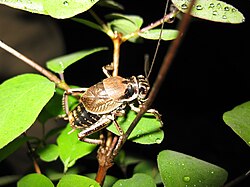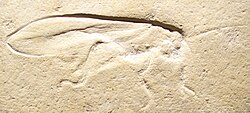| Hagloidea | |
|---|---|
 | |
| Cyphoderris buckelli | |
 | |
| Pycnophlebia speciosa, (Jurassic) | |
| Scientific classification | |
| Domain: | Eukaryota |
| Kingdom: | Animalia |
| Phylum: | Arthropoda |
| Class: | Insecta |
| Order: | Orthoptera |
| Suborder: | Ensifera |
| Infraorder: | Tettigoniidea |
| Superfamily: | Hagloidea Handlirsch, 1906 |
| Families | |
See text | |
The superfamily Hagloidea are insects belonging to the order Orthoptera: Ensifera; [1] they are now represented by the extant Prophalangopsidae, with many extinct genera and families (see below). The group in its broad sense has been suggested to be paraphyletic and ancestral to all other members of Tettigoniidea. [2]